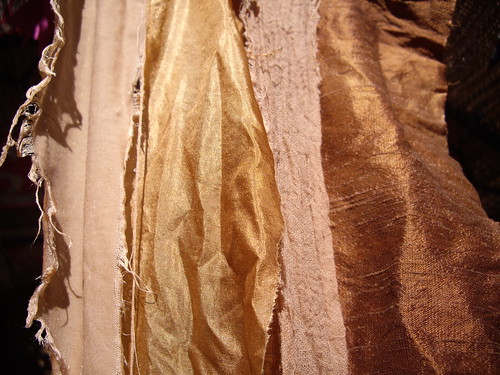It’s a long while since I’ve done any experimenting with natural dyes, but I was thinking about tea dyeing again this morning. This came about because I’ve been saving all of my used tea bags (ordinary black tea and lots of different herbal varieties) and stashing them in the freezer. They’re all in bags, a month’s worth at a time. It turns out that I drink rather a lot of tea, so six months’ tea bags are now taking up rather a lot of space.
The reason I’ve been saving them this way is that I’ve been thinking about a (currently imaginary) project of making “tea dresses”. The dresses would be made from organic cotton, or vintage nightdresses, or maybe old doilies and table linens of various descriptions. Each one would be dyed after its construction, in a month’s worth of tea bags. Theoretically each one would be a different colour, as no two months’ tea combinations would be the same. (Actually, they’ll almost certainly all be beige, but that’s not necessarily a bad thing.)
However, something suddenly occurred to me, after watching a detergent advert on the telly.
How do you wash a dress that’s been dyed with tea, when modern detergents are specifically designed to remove precisely this kind of stain?
The Internets provided me with answers ranging from “add salt to the dye bath” to “rinse with a vinegar solution”, and people also suggested washing at various temperatures and with different kinds of detergents.
Conveniently, a friend’s husband is something of a detergent expert (how useful!), and he had this helpful advice:
“Effectively you’re using a tea as a direct dye so it will be prone to fading. But there are a couple of things you can do to help. After you’ve stained the cotton, let it dry and leave it for a few days. The air will help to set the colour a bit. You could also experiment with a hand wash in bicarbonate of soda which will darken the colour somewhat (alkali does that to tea for the same reason that it gets lighter when you put lemon juice in it). From a detergent point of view, we rely strongly on bleach to get rid of tea so avoid powder detergents and detergent additives such as Vanish. Then wash on a cool short cycle and you will create unfavourable conditions for tea removal. Just don’t spill coffee down yourself ;)”
Fantastic! So another friend’s suggestion of using a rubbish detergent (as she never manages to get stains out of anything, apparently) is a good one, as is only washing in cool water. The bicarb/alkali information is very interesting, and I happen to have some litmus paper in the Shed that I can use to find out what sort of pH produces good results in terms of both colour and fastness.
I know that these dresses will fade over time, and to me that’s going to be part of their charm. I plan to make them fairly plain, and then embellish them as I go along, so they’ll effectively remain a constant work in progress. I might even keep collecting my tea bags, and re-dye them once a year.
You all know what I’m like for getting all excited about a project and then wandering off before it ever gets past the imaginary stage, but I should probably actually try to make a start on this one soon. Not least because I don’t really want to have to explain to the removal men why I’m moving six months’ worth of frozen teabags from one house to another!

